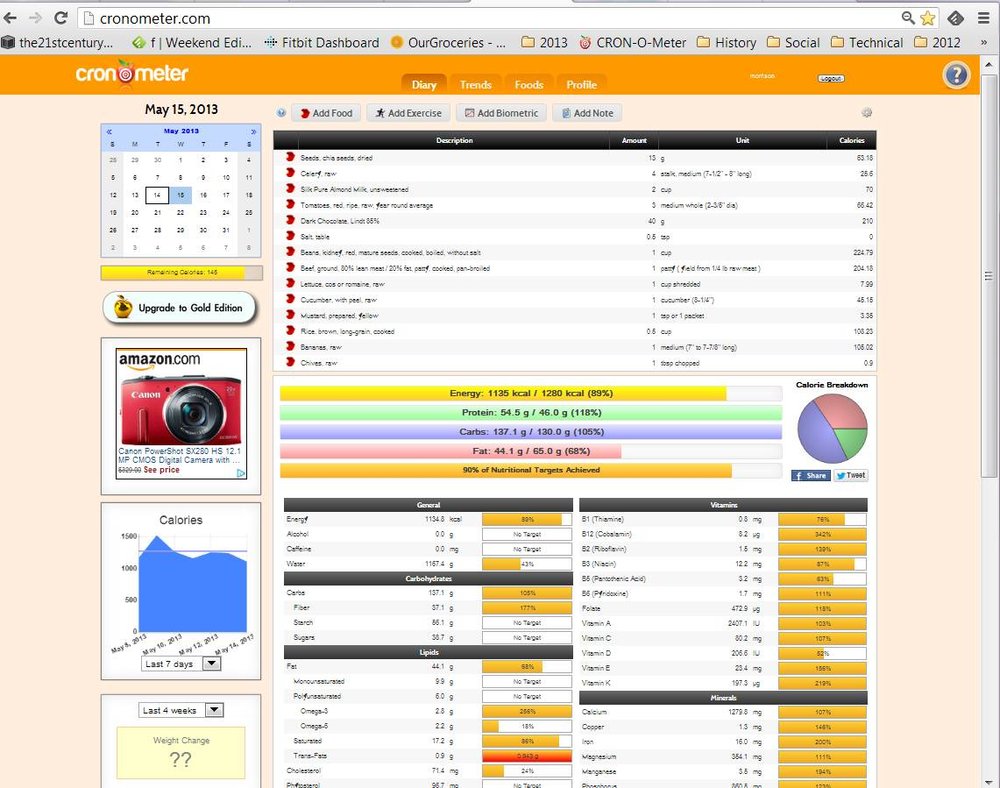The Psychology of Weight Loss
/ I am now within 2 pounds of the weight I was in my early-30s and I am confident of reaching the goal. It has taken me several years to get here. When I first started, the way I approached weight loss was quiet different that it is now. This blog post documents the transitions in my thinking over the past few years.
I am now within 2 pounds of the weight I was in my early-30s and I am confident of reaching the goal. It has taken me several years to get here. When I first started, the way I approached weight loss was quiet different that it is now. This blog post documents the transitions in my thinking over the past few years.
The goals I started with were:
 Take at least 7,000 steps per day. I had a simple pedometer to count my steps. It had some oddities (sometimes didn’t count when I was walking) so I replaced it with a Fitbit. I quickly discovered that the bounces on my Swopper chair counted as a step and, very briefly, decided that maybe I should take the Fitbit off so that they would not be counted. Then I decided that it was OK if they were counted…that the relative activity between days and the spread of activity throughout the day were a good measure. I still have a form of this goal although it is 12,000 or more steps and the calories burned measure is more important at this point.
Take at least 7,000 steps per day. I had a simple pedometer to count my steps. It had some oddities (sometimes didn’t count when I was walking) so I replaced it with a Fitbit. I quickly discovered that the bounces on my Swopper chair counted as a step and, very briefly, decided that maybe I should take the Fitbit off so that they would not be counted. Then I decided that it was OK if they were counted…that the relative activity between days and the spread of activity throughout the day were a good measure. I still have a form of this goal although it is 12,000 or more steps and the calories burned measure is more important at this point.- Eat only when and while you are hungry. This will always be a challenge - particularly when I am not at home and sometimes there too. I enjoy good food tremendously and it is intertwined with family gatherings and celebrations. The psychological challenge is to not think like a Stone Age hunter gatherer that needed to gorge any time food became available because there would be lean times just ahead. The probability of not having food readily available any time I am hungry is practically 0 - but it is hard to remember that when something delicious is in front of me. I’ve learned to savor a taste - but not overindulge.
- Reduce weight to what it was when I was 45. I thought it was a realistic goal - about 20 pounds. I’d held steady at that weight for about 5 years so I knew it should be a comfortable weight for me. I started weighing myself first thing every morning and devising little rewards for when I was at a ‘new low.’
Those three goals did work for the first 20 pounds and the weight came off easily enough that I established a new goal:
- Reduce weight to what it was with I was 35. It was another 10 pounds to come off.
And the pounds didn’t come off. I maintained my weight easily but could not seem to take off any more pounds. A year or so went by and I was prompted by a nutrition course to update my goals:
 Burn 2000 calories per day. The Fitbit estimates the number of calories burned so I used that as my key indicator.
Burn 2000 calories per day. The Fitbit estimates the number of calories burned so I used that as my key indicator.- Stay below the calorie level recommended to lose 1 pound per week. The cronometer.com tool calculates the calorie level allowed based on my height and weight. I logged my food into the tool to determine how many calories I was consuming. The tool also helped me internalize the portion size for a ‘serving.’
- Get at least 90% of my nutritional needs from food. The cronometer.com tool helped with this goal too. It totals up the nutrients from the food log. Initially, I was in the 80 percent range but learned very quickly how to improve my diet. I stopped taking supplements for vitamins and minerals that I readily get from the foods I eat.
Those goals got me to where I am now and are still working very well. But I’ve added a new goal now that I am nearing the weight goal:
- Achieve body proportions close to what they were when I was 35. I found a table of measurements I had made of myself at 35 - stored away in an old journal - and decided to see how close I was getting to that size again. There are some differences - enough that I’ve started exercises to hone some muscles (particularly tummy and upper arms). Otherwise - the measurements are very similar.
I’m close enough to my goal that I am already thinking about what is next. Sustaining a new weight will probably take some effort but probably won’t be as hard as getting there in the first place. Maybe my next goal - with the added calories allowed in sustain mode - will be to:
- Get 100% of my nutritional needs from food.

























